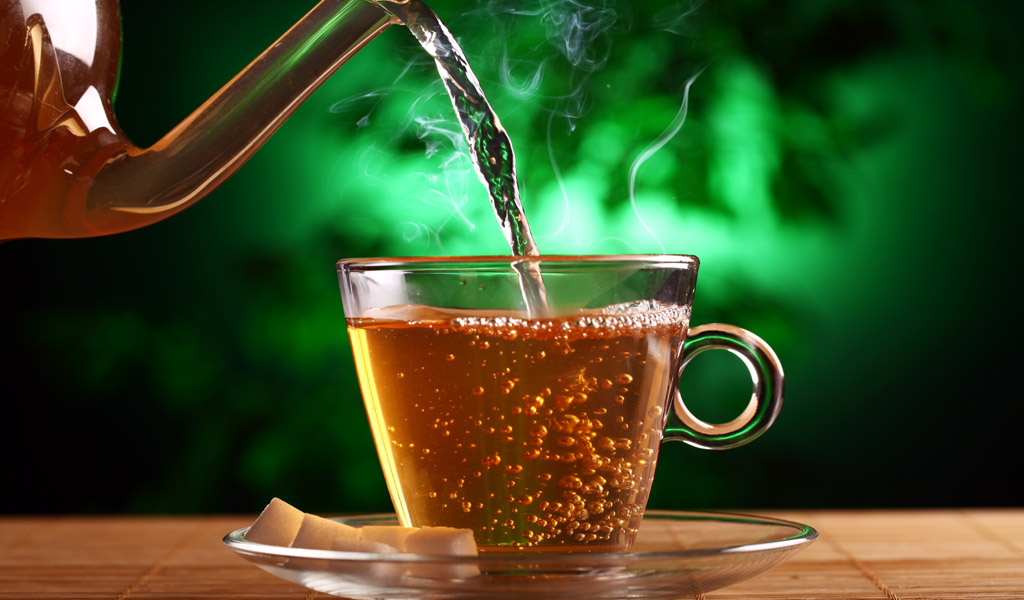
Green tea is a living fountain of youth, filled with anti-aging antioxidants that nourish, protect, and refresh from the inside out
The Origins and History of Green Tea
Green tea has a long and storied history, originating in China over 4,000 years ago. According to legend, the Chinese emperor Shennong discovered tea when leaves from a wild tea bush fell into his boiling water. The first known references to green tea as a beverage date back to the Tang Dynasty in China around 600 AD. From China, the consumption of green tea spread to Japan, becoming an important cultural and social tradition. Matcha green tea played a key role in traditional Japanese tea ceremonies. Green tea grew in prominence worldwide in the early 1900s when researchers began to uncover its potential health and medicinal benefits. It continues to grow in popularity globally as a healthy beverage choice.
Green Tea Production and Processing
All types of tea, including green tea, come from the leaves of the Camellia sinensis plant. The key difference lies in how the plucked leaves are processed. For green tea, the freshly picked leaves are quickly heated or steamed to prevent oxidation. This preserves the compounds in the leaves and produces tea with a fresh, green color. Other true teas like black tea and oolong tea undergo partial or full oxidation during processing, altering the color and flavor. Popular varieties of green tea include matcha, sencha, gunpowder, and bancha. Matcha is made from ground tea leaves and has higher antioxidant content. After processing, green tea can be rolled, pan-fired, or steamed before being dried and packaged. High quality green tea is harvested by hand and often comes from early spring tea leaves.
Active Compounds and Ingredients in Green Tea
Green tea owes much of its health benefits to its robust nutritional profile. Key active ingredients include:
- Catechins – These potent antioxidant plant compounds have anti-inflammatory, anticancer, and fat burning effects. The most abundant catechin in green tea is EGCG.
- L-theanine – This amino acid boosts alpha brain waves to induce a state of calm, focused relaxation. It can offset the jittery effect of caffeine.
- Vitamin C – Green tea is rich in immune-boosting vitamin C. Just one cup provides around 5% of the daily recommended intake.
- Polyphenols – These micronutrients have antioxidant, anti-diabetes, anti-cancer and brain protecting abilities.
- Flavonoids – This plant compound has anti-inflammatory effects that may benefit heart health.
- Caffeine – While less than coffee, green tea contains a stimulant dose of caffeine to enhance alertness.
Choosing a High Quality Green Tea
Not all green tea is created equal when it comes to purity and nutritional content. Here are some tips for finding a high quality green tea:
- Choose organic – This avoids pesticides and ensures the leaves are not irradiated.
- Check the harvest date – Fresher tea will be higher in antioxidants. Ideally it will have been harvested within the past 6 months.
- Read the label – Tea grown and produced in Japan, China, or Sri Lanka is typically highest quality.
- Avoid added flavors or sweeteners – Plain tea has the purest taste and nutrition content.
- Select loose leaf or full tea leaves – This results in a better flavor profile.
- Consider single estate tea – This tea comes from just one farm, emphasizing terroir.
- Seek out matcha for maximized benefits – Matcha has the highest antioxidant levels.
- Proper Storage of Green Tea
To retain the freshness and prevent degradation of compounds like EGCG, proper storage of green tea is important:
- Use airtight containers – Oxygen can cause deterioration. An airtight sealed tin or jar works best.
- Store in a cool, dark place – Light and heat also speed up deterioration. A cupboard or pantry is ideal.
- Limit storage time – For maximum freshness and antioxidant content, use green tea within 6 months.
- Refrigerate matcha powder – To preserve color and nutrients, store matcha powder in the fridge.
- Consider the freezer – Green tea can last over a year stored in an airtight container in the freezer.
- Brewing the Perfect Cup of Green Tea
By following a few simple guidelines, you can optimize the health benefits and enjoy the best flavor from your green tea:
- Use high quality filtered water – Spring or purified water allows the delicate flavors to shine.
- Pay attention to water temperature – Aim for 160-180 Fahrenheit. Water that is too hot can scald the leaves.
- Use one teaspoon of loose leaf tea per 8oz cup – Adjust tea amounts based on cup size.
- Steep for 1-3 minutes max – Oversteeping can make green tea bitter and astringent.
- Avoid reusing tea leaves – Reusing leaves results in diluted flavor and fewer antioxidants.
- Try different steep times – Experiment to find your optimal brewing time and strength.
- Squeeze the tea bag before removing – This maximizes the beneficial compounds that infuse.
- Sweeten sparingly – Honey or a little sugar allows the tea’s flavor to still shine.
- Potential Health Benefits of Drinking Green Tea
Research continues to uncover connections between green tea consumption and wellness:
Weight Loss
- The caffeine and EGCG in green tea can boost metabolism by 4-5% and enable greater fat breakdown.
Heart Health
- Antioxidants in green tea improve artery flexibility and lower LDL cholesterol and blood pressure.
Cancer Prevention
- Green tea antioxidants may disrupt tumor growth pathways and boost the effects of chemotherapy drugs.
Diabetes Management
- By improving insulin sensitivity and reducing blood sugar spikes, green tea may aid diabetes management.
Brain Function
- L-theanine and caffeine work synergistically to enhance attention, memory, mood, and work productivity.
Anti-Aging Effects
- The antioxidants in green tea fight free radicals that accelerate skin aging. Green tea can also reduce sun damage when applied topically.
Immune System Support
- The vitamin C content in green tea supports immune function. EGCG also has antimicrobial effects against bacteria and viruses.
Oral Health
- Compounds in green tea combat bacteria that cause cavities, gum disease, and bad breath.
Digestive Health
- Green tea has been shown to alleviate symptoms associated with inflammatory bowel diseases.
Bone Health
- The fluoride content in green tea may improve bone mineral density to reduce fracture risk as we age.
Safety and Potential Side Effects of Green Tea
For most people green tea is very safe, especially when consumed in moderation. However, there are some things to consider:
- Caffeine sensitivity – Those who are caffeine-sensitive may experience jitteriness or insomnia from the caffeine content.
- Blood thinners – The vitamin K content may interfere with blood thinning medications like warfarin.
- Irritable bowel syndrome – The tannins in green tea may exacerbate GI upset in some people.
- Iron absorption – Compounds in green tea can bind to non-heme iron from plant sources, inhibiting absorption. Have tea between meals.
- Pregnancy and breastfeeding – Caffeine intake should be limited during pregnancy and breastfeeding.
- Children – Due to the stimulant effects, green tea is not recommended for children under 16.
- Medication interactions – Green tea may interact with certain medications including some antibiotics and blood pressure medications. Speak with a doctor or pharmacist first.
As a generally healthy beverage choice, green tea can be enjoyed daily as part of a balanced diet and active lifestyle. Pay attention to your individual reactions to find the health benefits and enjoyment that work for you.






